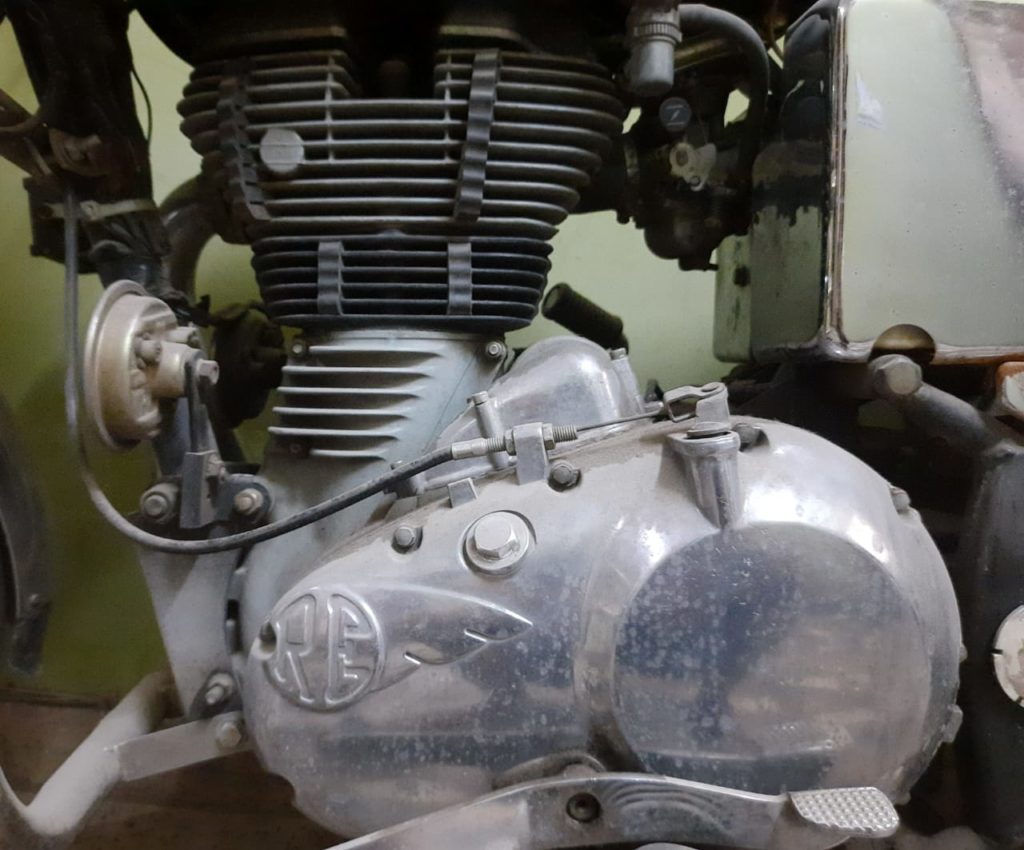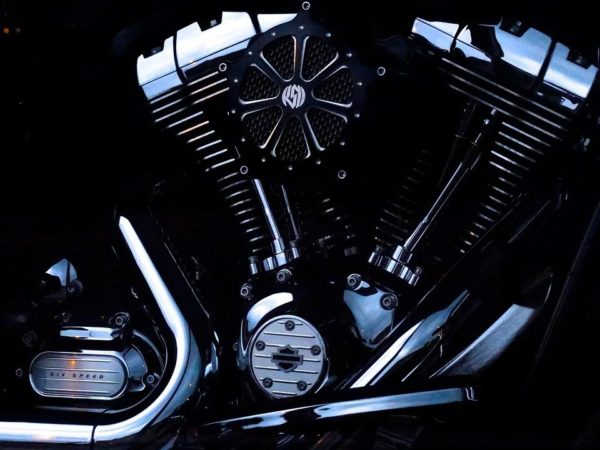I was riding my Harley yesterday and saw a man struggling to cool down his motorcycle engine. I helped the man and wondered, what shouldn’t I write the post about, why the motorcycle engine overheats?
Motorcycle engines overheat because of the poor air-fuel mixture, high REV, radiator problems, stressed engine, low oil, and coolant level. In the long run, engine overheating can permanently damage your motorbike. So it would be better to avoid these reasons.
Let’s look at what it means for you and what you can do about it. While writing this post, I leave no stone unturned so you can get all your knowledge and boost your motorbike engine health.
Table of Contents
Why Do Motorcycle Engines Overheat?
Engine heating is expected, thanks to combustion continually happening in your motorbike. While overheating isn’t so common, engine overheating might be caused because of several reasons.
I recommend checking each factor that contributes to motorcycle engine overheating.
| Factors Causing Engine Overheating: |
| Low oil thus increasing friction. |
| Bad quality oil. |
| Lack of coolant thus interfacing the heat exchange. |
| Improper air-fuel mixture causing the lack of heat transportation. |
| High REM causes extra pressure on the engine. |
| Radiator leakage and malfunctioned radiator fan cause the overheating. |
Low Oil:
Before understanding how the low oil can cause engine overheating, you should first know why we use motorcycle oil?
Riding a motorcycle causes friction between the piston and cylinder in the engine; this friction evolves the unnecessary heat. Oil in between the cylinder and piston acts as lubricants reducing friction and thus heat.
Low oil does not only cause engine overheat but also can burn the clutch plate and cylinder lining.
I always recommend checking the oil level before going for a long ride.
Bad Quality Oil:
Sometimes the engine does not overheat because of low oil but because of oil type.
Many of us don’t bother to cross-checking the oil type the technician is using. Even some of us leave the whole oiling work to the technician.
For instance, some technicians use mineral oil in the high CC engine and synthetic oil in the low CC engine.
Using mismatched oil in your motorbike can harm your motorcycle engine instead of cooling it.
Experts always recommend checking the oil level and its type before going for a long ride.
And always remember telling the technician about your motorbike engine demand before you miss the boat.
Here’re recommended oil change frequency-time:
| Oil Type: | When to Change Oil: |
| Synthetic oil | After covering 8000 miles. |
| Semi-synthetic oil | When your motorbike covers more than 5000 miles. |
| Mineral oil | After covering 2000 miles. |
Coolant:
After checking the oil level and types, now it’s time to check the coolant level.
Coolant is the fluid that keeps the internal motorbike parts’ temperature in the range. Specifically, the coolant helps to cool down the motorbike exhaust and engine temperature in limit.
Not only the lack of coolant might overheat the motorbike engine, but also the type and constituents of coolant can overheat the engine.
For instance, in some coolants, you can mix the water in 50:50 quantity.
And if the quantity isn’t evenly distributed, then the coolant may not work effectively.
Also, adding water to the coolant lowers its boiling point, which isn’t good for your motorbike engine.
Coolant has a hygroscopic property which means it can absorb water from the environment around it. And that’s why you should always avoid using the opened bottle coolant.
There are mainly two types of coolant: Ethylene glycol and propylene glycol. If you don’t ride your motorbike too harshly, then the Ethylene glycol is more than enough for your motorbike.
And if you’re a professional rider, then you should go with a propylene glycol-type coolant.
Considering changing the motorbike oil in a year or two for better performance.
Air-Fuel Mixture:
The air-fuel mixture is the most common problem causing engine overheating; thus, it would be better to check the carburetor first if you ever face overheating issues.
In the carburetor, the air and fuel combine together for proper combustion. For proper functioning and heat transfer, the air and fuel should be in equal quantity. The lean air-fuel situation is caused when there’s not enough air and opposite for rich air-fuel mixture.
For cooling the exhaust and engine, the fuel and air both have to absorb the heat produced by the engine.
But in the lean air-fuel, the air absorbs all heat alone and transfers the heat throughout the engine and exhaust.
While in a rich air-fuel mixture, the fuel absorbs all heat alone beyond its capacity.
Although it’s a slow process, it can still seriously harm your engine.
And that’s why experts always recommend checking the mixture constituent in the regular interval of time.
High RPM:
Who doesn’t love riding motorcycles at high speed? But is it suitable for your motorbike?
No, riding regularly at high speed can also cause motorbike engines to overheat. And it’s more common in old motorcycles.
When riding at high RPM, your motorbike engine has to push harder to catch high RPM. And the motorbike engine makes it even harder if there’s something wrong with the piston and cylinder.
Tight chain, low tire pressure, high friction between piston and cylinder are some of the reasons why your motorbike engine pushes even more hard.
I recommend taking a 15-minute break after riding for more than 1 hour to cool down the engine.
Radiator Problems:
Problems with the radiator, including leakage and faulty fan, can also make your motorbike engine overheat.
In the radiator, there’s a coolant that makes your engine cool, and if there’s any leakage, the coolant level will go down below the threshold amount.
You must check any leakage if your motorbike overheats frequently.
The next problem with a radiator is the faulty fan.
Ok, guess, how the coolant cools the engine? Obviously, the coolant cools the engine with the help of a radiator fan.
If ever the radiator fan malfunction, then heat exchange couldn’t be possible, causing the temperature increase.
In this way, the faulty radiator fan doesn’t cool the coolant causing the coolant to carry more heat than its capacity. And this ultimately caused the engine to overheat.
Don’t forget to check these radiator problems if your motorbike engine overheats.
What to Do When Motorcycle Engines Overheat:
I mentioned some reasons why your motorcycle engine overheats. But how will you detect if your motorbike engine overheats or not?
Although new motorcycles have a heat indicator that will indicate if there’s something wrong with your motorcycle engine. Still, it would be best to not rely on the indicator solely.
Detecting engine overheating isn’t wrapping your head around something. You just need to focus on some signs.
The most significant sign of motorcycle overheating is the burning sound and extra smoke coming from the exhaust. Additionally, you’ll feel extreme heat on your feet while riding.
If your motorbike engine overheats ever, then you must pull over your motorbike and wait at least 15 minutes to cool down the motorbike engine again.

© motorbikespace.com – Please free to share with attribution and backlink. Thank you!
How to Prevent Motorcycle Engines Overheating:
Engine overheating might cause some severe damage to your motorbike. Unfortunately, there’re many motorbikes ruined because of engine overheating.
The best part is, you can prevent engine overheating. Here’re some ways through which you can avoid engine motorbike overheating.
| How to Prevent Your Motorbike Engine from Overheating: |
| Check the oil level of your motorbike. |
| Check the coolant level. |
| Always use suitable oil for your motorbike. |
| Check if any leakage is there. |
| Check the radiator fan. |
Check Oil:
Oil helps to reduce the friction between cylinder and piston. And in the absence of enough oil, the friction will cause overheating.
It’s always better to check the oil level before going for a long ride.
Suitable Oil:
It’s not always the lack of oil that overheats the motorbike engine.
Unsuitable motorcycle oil could also hamper engine performance. It’s always better to put suitable oil which your motorbike engine demands.
Check Coolant Level:
As mentioned above, coolant protects the engine from overheating. It would be best if you check the coolant level every six months.
Check Leakage:
If you always find a low level of coolant every two months, then you should focus on radiator leakage and see if the coolant is leaking or not.
Check Radiator Fan:
If everything goes right and the motorbike is still suffering from overheating, then you shouldn’t forget to check the radiator fan before you miss the boat.
Also, read how the motorbike cooler works and cool your motorbike engine. Read Here.
Frequently Asked Questions:
What could be the possible reason behind your motorbike overheating?
Motorbike may overheat because of the poor air-fuel mixture, high REV, radiator problems, stressed engine, low oil, and coolant level.
Does using poor quality oil overheat your motorbike engine?
Yes, using poor-quality oil could overheat your engine.
How does high RPM overheat your motorbike engine?
When riding at high RPM, your motorbike engine has to push harder to catch high RPM and thus making your motorbike overheat.
How wrong air-fuel mixture overheat your motorbike engine?
For proper functioning and heat transfer, the air and fuel should be in equal quantity.
Does radiator problems can also overheat your motorbike engine?
Yes any problem with the radiator, including leakage and faulty fan, can also make your motorbike engine overheat.
Final Verdict:
Why does the motorcycle engine overheat? Motorcycle engines overheat because of the poor air-fuel mixture, high REV, low oil and coolant level, problem in the radiator, and stressed engine. Engine overheating, in the long run, can permanently damage your motorbike. So it would be better to avoid these reasons.
Don’t forget to check the oil and coolant level if your motorbike ever overheats.
Here are Some of My Favorite Riding Gears:
Thank you for reading this article. I hope you found it helpful as you build your riding journey successfully.
Here are some riding gears I use as a rider that I hope you’ll also find helpful.
These are affiliate links, so I’ll earn a commission if you decide to use any of them. But in all honesty, these are the same riding gears that I use and recommend to everyone, even my own family.
Motorbike Riding Pants:
For getting started, I like Scorpion EXO Covert Jeans for men (check the latest price on Amazon.com) and Indigo Protective Riding Jeans for women (check the latest price on Tobacco Motorwear).
These riding pants are comfortable so you can use these pants in summer, and these pants have a lot of space for using knee guards.
Motorbike Riding Helmet:
Throughout my riding life, I used several helmets, and almost all helmets protect your head well. Still, I personally prefer YM- 929 Yema helmets as it comes with Bluetooth and aerodynamic ABS shells (check the latest price on Amazon.com).
And suppose you want an eye-appealing and yet effective helmet. In that case, you can go with Icon Airform Sacrosanct Helmet (check the latest price on Revzilla).
Motorbike Riding Jacket:
Jackets are crucial to protect your upper body. Honestly, every rider has a dream to have an affordable yet best riding jacket. And that’s why I personally recommend the Alpinestars T faster motorbike jacket because of the protection and comfort it offers (check the latest price on Amazon.com).
Motorbike Riding Gloves:
Almost all riding gloves perform well by protecting your hands from sunburn and cool nights. And if you’re a serious rider, then you should go with Alpinestars SMX-1 Air v2 Glove, which is lightweight and offers you excellent protection. (check the latest price on Revzilla).
John, this side! My passion for motorbikes started when I was 12. I experienced many accidents and even lost some friends too. And it inspired me to create this website so that no parents in this world would lose their child while enjoying riding.


